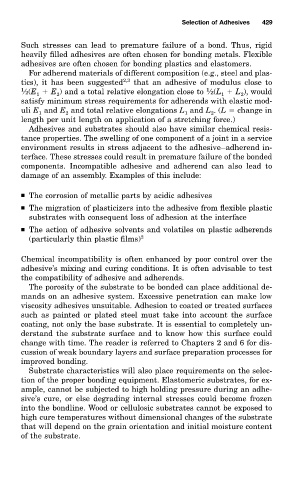Page 496 - Handbook of Adhesives and Sealants
P. 496
Selection of Adhesives 429
Such stresses can lead to premature failure of a bond. Thus, rigid
heavily filled adhesives are often chosen for bonding metals. Flexible
adhesives are often chosen for bonding plastics and elastomers.
For adherend materials of different composition (e.g., steel and plas-
tics), it has been suggested 2,3 that an adhesive of modulus close to
1 1
⁄2(E E ) and a total relative elongation close to ⁄2(L L ), would
1
2
1
2
satisfy minimum stress requirements for adherends with elastic mod-
uli E and E and total relative elongations L and L .(L change in
1
1
2
2
length per unit length on application of a stretching force.)
Adhesives and substrates should also have similar chemical resis-
tance properties. The swelling of one component of a joint in a service
environment results in stress adjacent to the adhesive–adherend in-
terface. These stresses could result in premature failure of the bonded
components. Incompatible adhesive and adherend can also lead to
damage of an assembly. Examples of this include:
The corrosion of metallic parts by acidic adhesives
The migration of plasticizers into the adhesive from flexible plastic
substrates with consequent loss of adhesion at the interface
The action of adhesive solvents and volatiles on plastic adherends
(particularly thin plastic films) 2
Chemical incompatibility is often enhanced by poor control over the
adhesive’s mixing and curing conditions. It is often advisable to test
the compatibility of adhesive and adherends.
The porosity of the substrate to be bonded can place additional de-
mands on an adhesive system. Excessive penetration can make low
viscosity adhesives unsuitable. Adhesion to coated or treated surfaces
such as painted or plated steel must take into account the surface
coating, not only the base substrate. It is essential to completely un-
derstand the substrate surface and to know how this surface could
change with time. The reader is referred to Chapters 2 and 6 for dis-
cussion of weak boundary layers and surface preparation processes for
improved bonding.
Substrate characteristics will also place requirements on the selec-
tion of the proper bonding equipment. Elastomeric substrates, for ex-
ample, cannot be subjected to high holding pressure during an adhe-
sive’s cure, or else degrading internal stresses could become frozen
into the bondline. Wood or cellulosic substrates cannot be exposed to
high cure temperatures without dimensional changes of the substrate
that will depend on the grain orientation and initial moisture content
of the substrate.

